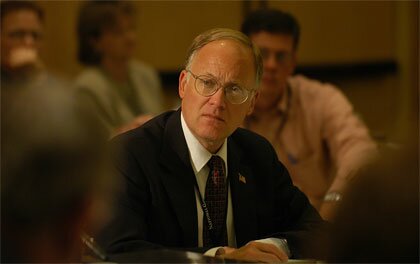A Classical Vermont Tragedy: In Which Jim Douglas Faces A Tangled Prophecy, and Sick Buildings Do Come to Dunsinane
Incumbent executives tend to develop an aura not simply of power, but of invulnerability. Each re-election adds another layer of varnish to the exterior. Forget that the human being in question was once seen as utterly unelectable by a vast chunk of the state’s voters; after two years in a Governor’s chair, anyone comes to project attitude.

But inside, these men and women worry.
Not continuously and not to the point of paralysis, but these executives come to fear certain issues and situations in the way that Macbeth fears Birnam Wood: in his heart, and in his gut, long before he sees it actually march on Dunsinane.
Something about the very insolubility and impossibility of the problem bears the stamp of prophecy, of inevitability and doom.
Now take Jim Douglas, and take the Bennington Sick Building situation.
You know, the building where some state workers developed a rare disease called sarcoidosis, and others developed asthma.
Douglas’s last re-election party soured almost immediately with the worsening of conditions at the Bennington State Office Building; what had been a straightforward commitment to move all workers out in a 45-day period soon turned into a nightmare of bureaucratic delay and moldy temporary trailers.
The building pressure culiminated in the infamous “testy” press conference of last February, during which Douglas accused the media of parroting Democratic talking points — only to call the press into his office a bit later and apologize for his bluster.
But suffice it to say that here in late 2007, with a nascent re-election campaign underway, Douglas can only view the Sick Building issue with genuine anxiety.
And as though part of some tangled prophecy, that level of anxiety is due to begin climbing again soon: the State has just signed off on a rehabilitation of the “sick” Bennington Office Building, rather than the more expensive process of siting workers downtown.
How much will unsicking the building cost? 9 million.
Moving workers out altogether? 18 million.
Not surprisingly, Douglas has opted for the cost-effective course, and he has the State Health Department report to back him up.
But as Robert Stannard of the Better Bennington Corporation, a backer of the move to downtown, put it:
“I think you’re really rolling big dice,” Stannard said of the plan to renovate the existing building. “By sticking with the old ways, it might work, but it might not. If it doesn’t work, boy oh boy, let’s get the names right now of those who are going to be on the hook for that.”
Really big dice indeed.
Look for this move toward rehabilitation to generate opposition not only from the involved workers and their union, but on the campaign trail as well. And look for Governor Douglas to come less than eagerly to his public discussions of same.
Think about it this way: Macbeth confesses to Lady Macbeth that his mind is full of scorpions — and that’s just at the threat that a distant forest might suddenly get up and march on the buildings making up his royal seat.
But even Macbeth never had to confront an invisible threat from within the actual buildings themselves.